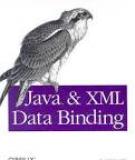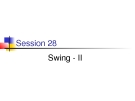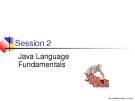Tài liệu Thư viện số
- Công nghệ thông tin (2019 )
- Điện tử viễn thông (1131 )
- Quản trị kinh doanh (1299 )
- Kế toán (1002 )
- Môi trường (968 )
- Du lịch (853 )
- Kiến trúc (417 )
- Xây dựng (1065 )
- Ngoại ngữ (300 )
- Y dược (1387 )
- Khoa học tự nhiên (847 )
- Khoa học xã hội (507 )
- Lý luận chính trị (556 )
- Sau đại học (243 )
- Tài liệu tham khảo khác (252 )
Danh mục TaiLieu.VN
- Mẫu Slide Powerpoint
- Luận Văn - Báo Cáo (344720)
- Kinh Doanh Marketing (65512)
- Kinh Tế - Quản Lý (48934)
- Tài Chính - Ngân Hàng (55898)
- Công Nghệ Thông Tin (142209)
- Tiếng Anh - Ngoại Ngữ (47066)
- Kỹ Thuật - Công Nghệ (134345)
- Khoa Học Tự Nhiên (107174)
- Khoa Học Xã Hội (82451)
- Văn Hoá - Nghệ Thuật (54408)
- Y Tế - Sức Khoẻ (173915)
- Nông - Lâm - Ngư (62504)
- Kỹ Năng Mềm (29016)
- Biểu Mẫu - Văn Bản (27610)
- Giải Trí - Thư Giãn (51994)
- Văn Bản Luật (198854)
- Tài Liệu Phổ Thông (402015)
- Trắc Nghiệm Online (213578)
- Trắc Nghiệm MBTI
- Trắc Nghiệm Holland
Java swing
When Java was first released, its user interface facilities were a significant weakness. The Abstract Window Toolkit
(AWT) was part of the JDK from the beginning, but it really wasn't sufficient to support a complex user interface. It supported everything you could do in an HTML form and provided free-standing frames, menus, and a few other
objects, but you'd be hard-pressed to implement an application as complex as Quicken or Lotus Notes. AWT also had its share of portability problems; it relied heavily on the runtime platform's native user interface components, and
it wasn't always possible to hide differences in the way these components behaved.
JDK 1.1 fixed a number of problems—most notably, it introduced a new event model that was much more efficient
and easier to use—but it didn't make any major additions to the basic components. We got a ScrollPane and a
PopupMenu, but that was about it. Furthermore, AWT still relied on the native components and therefore continued
to have portability problems.
(AWT) was part of the JDK from the beginning, but it really wasn't sufficient to support a complex user interface. It supported everything you could do in an HTML form and provided free-standing frames, menus, and a few other
objects, but you'd be hard-pressed to implement an application as complex as Quicken or Lotus Notes. AWT also had its share of portability problems; it relied heavily on the runtime platform's native user interface components, and
it wasn't always possible to hide differences in the way these components behaved.
JDK 1.1 fixed a number of problems—most notably, it introduced a new event model that was much more efficient
and easier to use—but it didn't make any major additions to the basic components. We got a ScrollPane and a
PopupMenu, but that was about it. Furthermore, AWT still relied on the native components and therefore continued
to have portability problems.
Từ khóa: Java swing, language programing, lập trình java, kỹ thuật lập trình, ngôn ngữ lập trình, lập trình máy tính
566 p trinh 06/12/2012 218 7





